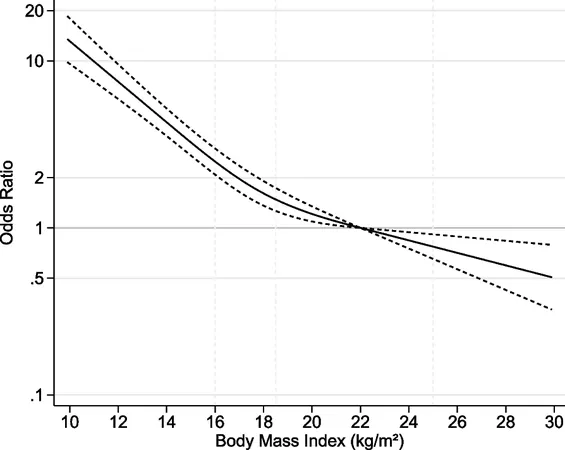
The Hidden Danger: How Low BMI Signals Higher Risks in Pneumonia Patients with Nontuberculous Mycobacterial Disease
2025-08-26
Author: Siti
Unraveling the Risks of Nontuberculous Mycobacterial Pulmonary Disease
Nontuberculous mycobacterial pulmonary disease (NTM-PD) is a chronic and debilitating infection, primarily affecting those with low body mass index (BMI). This condition is notorious for causing progressive lung damage, and studies indicate pneumonia is a leading cause of death for these patients. However, details on predicting pneumonia outcomes in this population have remained elusive.
Groundbreaking Research on BMI and Pneumonia Outcomes
A recent study, leveraging Japan's Diagnosis Procedure Combination database, examined over 13,000 patients with NTM-PD hospitalized for community-acquired pneumonia (CAP) from April 2012 to March 2020. The key focus was to analyze the impact of BMI on mortality, hospital stay, and readmission rates. This extensive research provides crucial insights into health management strategies for this vulnerable group.
The Alarming Statistics
Among the patients studied, with a median age of 79, a staggering 63.7% were women, and the average BMI stood at a precarious 17.6 kg/m². The in-hospital mortality rate reached 10.9%, with significantly higher risks for those categorized as underweight (BMI < 18.5 kg/m²). This group exhibited a dramatic increase in in-hospital mortality and longer hospital stays. Conversely, overweight individuals showed no heightened risks, illustrating a stark divide in outcomes.
Why Low BMI Matters More Than You Think
The findings speak volumes about the critical nature of maintaining a healthy BMI in patients suffering from NTM-PD. Those with a BMI less than 18.5 not only faced higher chances of succumbing to pneumonia but also dealt with a greater likelihood of readmission within a year after discharge. This correlation suggests that nutritional status plays a pivotal role in both physical condition and recovery.
The Connection Between BMI and Complications
Patients with low BMI often face malnutrition, compromising their immune response, thus heightening their susceptibility to pneumonia-related mortality. Additionally, the progression of NTM-PD leads to further lung damage, creating a vicious cycle that exacerbates health complications.
The Surprising Good News for Overweight Patients
Interestingly, patients categorized as overweight experienced improved survival rates during hospitalization for pneumonia. This phenomenon, known as the 'obesity paradox,' suggests that carrying extra weight may provide a buffer against the severity of certain medical conditions, including CAP.
What This Means for Patient Care
The study underscores the importance of BMI screenings and nutrition management in patients with NTM-PD. As healthcare providers storm into this new era of awareness, adopting strategies to monitor and maintain appropriate weight could transform treatment protocols and patient outcomes.
Conclusion: A Call to Action for Providers
With these compelling findings, there’s an urgent need for healthcare practitioners to integrate BMI evaluation into routine assessments for patients with NTM-PD. The clear link between low BMI and adverse outcomes not only sheds light on a critical aspect of patient care but also opens doors to enhancing survival rates and quality of life. As we delve deeper into these connections, it could mean the difference between life and death for many patients.



 Brasil (PT)
Brasil (PT)
 Canada (EN)
Canada (EN)
 Chile (ES)
Chile (ES)
 Česko (CS)
Česko (CS)
 대한민국 (KO)
대한민국 (KO)
 España (ES)
España (ES)
 France (FR)
France (FR)
 Hong Kong (EN)
Hong Kong (EN)
 Italia (IT)
Italia (IT)
 日本 (JA)
日本 (JA)
 Magyarország (HU)
Magyarország (HU)
 Norge (NO)
Norge (NO)
 Polska (PL)
Polska (PL)
 Schweiz (DE)
Schweiz (DE)
 Singapore (EN)
Singapore (EN)
 Sverige (SV)
Sverige (SV)
 Suomi (FI)
Suomi (FI)
 Türkiye (TR)
Türkiye (TR)
 الإمارات العربية المتحدة (AR)
الإمارات العربية المتحدة (AR)